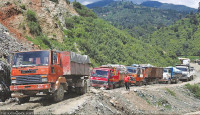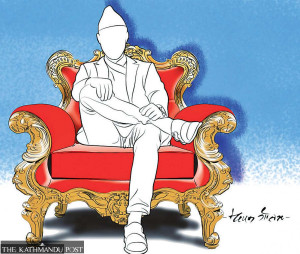Columns
Don’t be fooled
The NEPSE index recently hit an all-time high; the current political and economic turmoil has hardly made a dent.
Jagadish Prasad Bist
The Nepal Stock Exchange is flying high even though the economy is still trying to regain its footing after being clobbered by Covid-19 and a prolonged lockdown. On December 2, jaws dropped when the NEPSE index shot up to 2063.04 points, an all-time high since trading began in 1994. After a brief moment, when the market was thought to be crashing this past Sunday, NEPSE again closed at 2061.41 points on December 22; then, against all odds, it hit 2126.90 points before closing at 2,068.45 on December 23. That the dissolution of Parliament by the prime minister, when his own party holds a near two-thirds majority in the House, only brought a short-term drop (albeit a 90-point single-day drop before the circuit breakers were employed) is startling. NEPSE's stratospheric rise has got experts perplexed. It is important to analyse why stocks jumped, because the capital market doesn’t have strong foundations to handle such an upsurge, especially during an economic and political crisis.
As far as the stellar performance is concerned, there could be a number of reasons such as economic indicators, political matters, availability of liquidity in the market, alternative investment choices for investors, the performance of listed companies and many more. This time, the stimulus seems to have come from alternative investment choices and asymmetric information, political changes and the availability of liquidity in the market.
Before analysing the catalysts for this upsurge, let’s understand the market’s past performance and its relation to economic performance. What we know is that the NEPSE does not reflect a true picture of the economy, though theoretically the stock market is treated as an economic barometer. History shows that whenever the economy is devastated, the NEPSE has been unstoppable, be it during the post-earthquake era when the NEPSE reached a high of 1800 points or during the current global crisis. The ballooning stock market amidst year-long political chaos within the ruling party and the devastating effects of a pandemic is also not justifiable. This is nothing but the result of an immature capital market and naïve stock investors.
So what is causing NEPSE to skyrocket this season? This time, one of the catalysts is the nomination of Bishnu Poudel, general secretary of the Nepal Communist Party, as finance minister. Trends show that after Bamdev Gautam, vice-president of the Nepal Communist Party, received a ticket to the National Assembly—which was a clear indication that Yubaraj Khatiwada would be stepping down as finance minister—the market started getting positive vibes. Let’s not forget that Poudel was also the finance minister when the NEPSE set records during the post-earthquake period. The changed political situation—with Parliament dissolved, seven members of the Cabinet resigning and the ruling party heading towards a formal break—will make it tough for Poudel to convince investors. But the quick bounce back after Sunday points to other prominent factors.
Flush with cash
This time, lack of other investment opportunities in the market due to the pandemic and the availability of liquidity are also giving momentum to the stock market. People are free, and lacking other investment opportunities with gold prices already high, bank deposit rates dropping and investment in new businesses being doubtful during this period, the stock market is a priority choice. On top of that, digitalisation of the trading market has played a key role in making it easy for investors to put their money in stocks.
An equally important reason is the availability of funds in banking institutions and the composition of the capital market. This market is largely dominated by financial institutions (accounting for more than half of total market capitalisation), insurance companies, hotels and other sectors, in this order. The indicators are also showing that banking institutions are the major performers this time around too. This is because when other industries are struggling hard to maintain their performance, the banking industry has been able to maintain cheerful financial statements, even though first-quarter reports were down slightly year-on-year. An industry-wise comparison shows banks to be the most stable during this period. Therefore, it is understandable for investors to snap up their shares.
The information asymmetry and the characteristics of investors are also playing a significant role in pushing the market into a bullish trend. There are two types of investors in the market—institutional and individual. In this scenario, individual investors are stimulated by the market’s performance. Lack of understanding has long been causing such naïve investors to lose significant amounts of money. These investors mostly seek dividends and take a long position in the market. The direct benefit of such a position goes to institutional and experienced investors who profit by selling stocks to the general public when the market is bullish. This is what is happening in the market currently. The bullish trend is enticing the general public to make investments which reveal their immaturity. Immature because one usually would buy stocks when the market is bearish and sell them in a bullish market.
Misleading information
The authorities have been lacking in their responsibility to provide quality information, and social media is becoming an easy way to drag small investors into a trap through misleading information. Small investors, particularly in Nepal’s case, make investments based on rumours and not on any fundamental or trend analysis. It’s been some time now that rumours began spreading on different predatory social media platforms that the nomination of Bishnu Poudel and the start of the dividend declaration season was going to push the stock market upward. The result can be seen in the fine performance of the stocks of some companies that were stifled by the pandemic. For example, the hotel and hydro sub-indices are soaring. The hotel industry was devastated by the global shutdown of the tourism industry, and the construction activities of the hydro sector have been hit by supply chain disruptions.
Therefore, the current market is not a natural phenomenon, and this skyrocketing of the NEPSE index is nothing but very risky behaviour. The chances of losing one’s investment are very high, and this market is too big to fail. Though some companies may come up with dividends to entice their shareholders, such overvalued stocks are not going to match the level of the investment investors have made. What the authorities concerned should do right away is disseminate correct information. Equally important is to make investors aware that a bullish market is no time to take a long position, particularly during the type of political and economic crisis the economy is facing currently.
Similarly, the concerned need to gain small investor sentiments to stop the current market fluctuations—a rapid drop is just as bad as an unsustainable bubble. The small investors are very pliant to sensitive information. The ruling party may soon split, which may bring some uncertainty to the markets again. But there are rumours in the market that KP Oli might further the coup by dissolving provincial and local governments. Other rumours point to a counter-coup from the Madhav Kumar Nepal and Pushpa Kamal Dahal faction. If such rumours are not addressed properly, the situation could be worse than the case of 2016-17, when a large number of investors lost millions of rupees in the stock market.
Bist is a freelance researcher and writes on finance, economics and sociopolitical matters.




 21.12°C Kathmandu
21.12°C Kathmandu.jpg)















